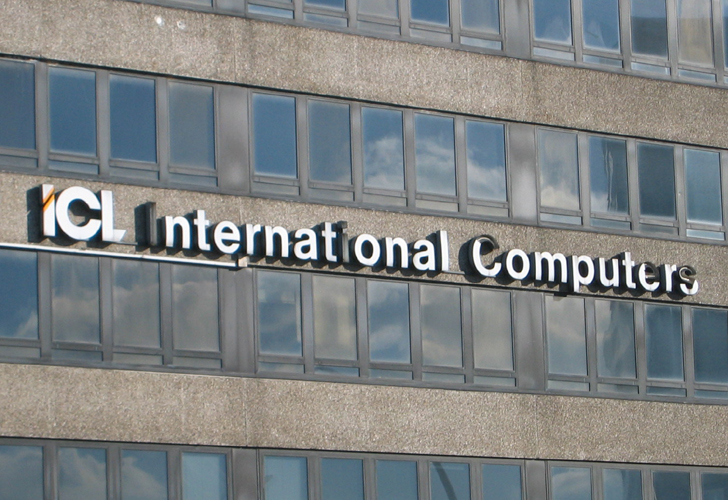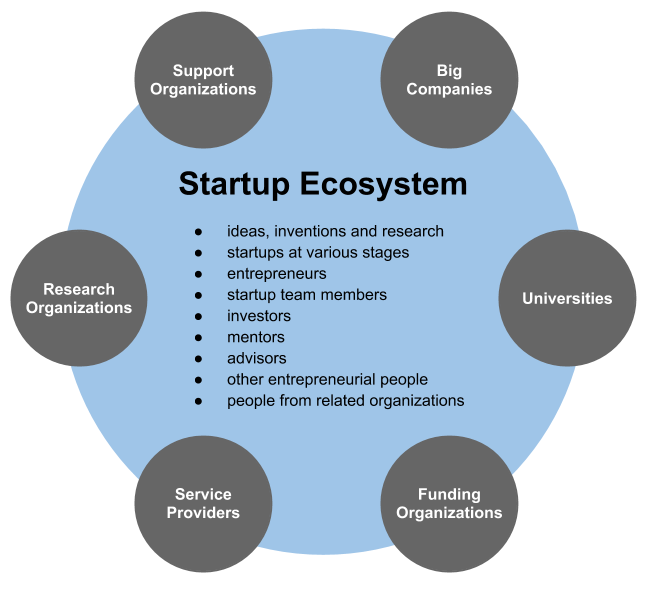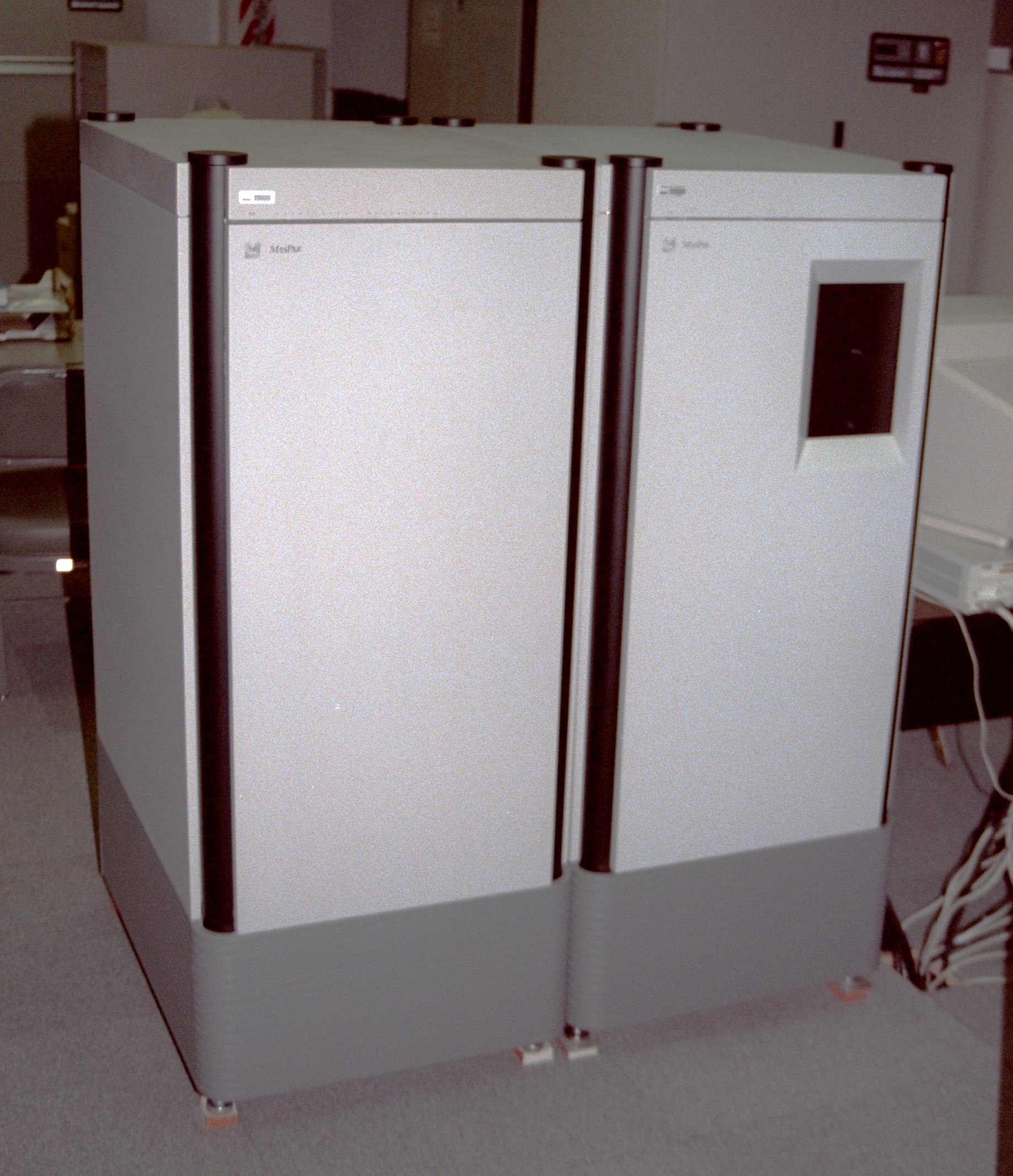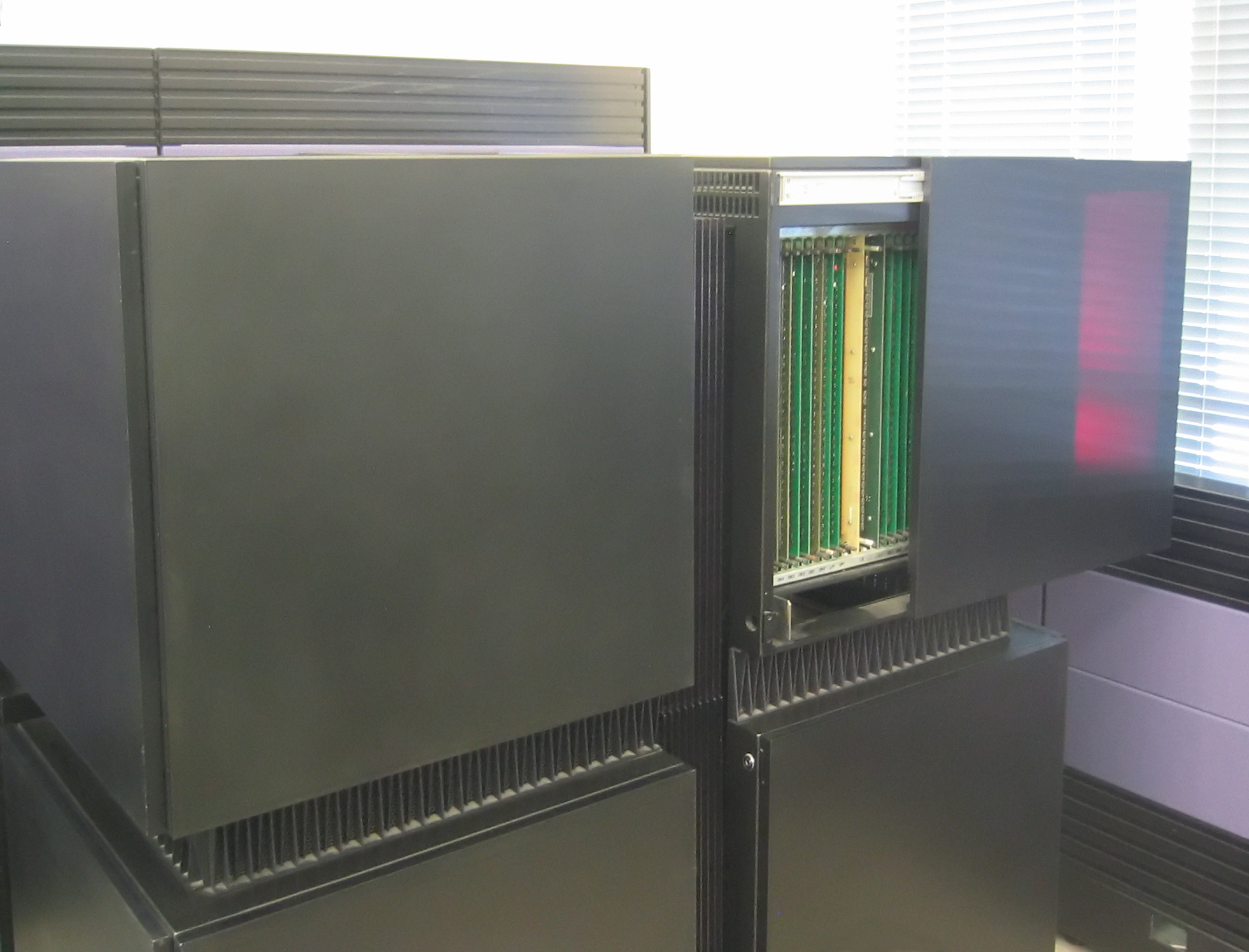|
ICL Distributed Array Processor
The Distributed Array Processor (DAP) produced by International Computers Limited (ICL) was the world's first commercial massively parallel computer. The original paper study was complete in 1972 and building of the prototype began in 1974. The first machine was delivered to Queen Mary, University of London, Queen Mary College in 1979. Development The initial Pilot DAP was designed and implemented by Dr Stewart F Reddaway with the aid of David J Hunt and Peter M Flanders at the ICL Stevenage Labs. Their manager and a major contributor was John Iliffe (computer designer), John K Iliffe, designer of the Basic Language Machine and known for Iliffe vectors. The pilot implementation had a 32×32 processing element arrangement. The ICL DAP had 64×64 single bit processing elements (PEs) with 4096 bits of storage per PE. It was attached to an ICL mainframe and its memory was mapped into the mainframe's memory. Programs for the DAP were written in DAP FORTRAN which was FORTRAN extended wit ... [...More Info...] [...Related Items...] OR: [Wikipedia] [Google] [Baidu] |
International Computers Limited
International Computers Limited (ICL) was a British computer hardware, computer software and computer services company that operated from 1968 until 2002. It was formed through a merger of International Computers and Tabulators (ICT), English Electric Computers (EEC) and Elliott Automation in 1968. The company's most successful product line was the ICL 2900 Series range of mainframe computers. In later years, ICL diversified its product line but the bulk of its profits always came from its mainframe customers. New ventures included marketing a range of powerful IBM clones made by Fujitsu, various minicomputer and personal computer ranges and (more successfully) a range of retail point-of-sale equipment and back-office software. Although it had significant sales overseas, ICL's mainframe business was dominated by large contracts from the UK public sector, including Post Office Ltd, the Inland Revenue, the Department for Work and Pensions and the Ministry of Defence (United Kingdo ... [...More Info...] [...Related Items...] OR: [Wikipedia] [Google] [Baidu] |
Start-up
A startup or start-up is a company or project undertaken by an entrepreneur to seek, develop, and validate a scalable business model. While entrepreneurship includes all new businesses including self-employment and businesses that do not intend to go public, startups are new businesses that intend to grow large beyond the solo-founder. During the beginning, startups face high uncertainty and have high rates of failure, but a minority of them do go on to become successful and influential, such as unicorns.Erin Griffith (2014)Why startups fail, according to their founders, Fortune.com, 25 September 2014; accessed 27 October 2017 Actions Startups typically begin by a founder (solo-founder) or co-founders who have a way to solve a problem. The founder of a startup will do the market validation by problem interview, solution interview, and building a minimum viable product (MVP), i.e. a prototype, to develop and validate their business models. The startup process can take a long pe ... [...More Info...] [...Related Items...] OR: [Wikipedia] [Google] [Baidu] |
Massively Parallel Computers
Massively may refer to: *Mass Mass is an Intrinsic and extrinsic properties, intrinsic property of a physical body, body. It was traditionally believed to be related to the physical quantity, quantity of matter in a body, until the discovery of the atom and particle physi ... * Massively (blog), a blog about MMOs {{disambiguation ... [...More Info...] [...Related Items...] OR: [Wikipedia] [Google] [Baidu] |
ICL Mainframe Computers
ICL may refer to: Companies and organizations * Idaho Conservation League, environmental organisation in the United States * Imperial College London, a UK university * Indian Confederation of Labour * Indian Cricket League * Inorganic Chemistry Laboratory of the University of Oxford * ICL Group Ltd., an Israeli multi-national chemical company * , the English name for the Chengdu Hi-Tech Disaster Reduction Institution * International Computers Limited, a UK company acquired by Fujitsu * International Confederation of Labor, a global anarcho-syndicalist union federation * International Congress of Linguists * International Consortium on Landslides, Kyoto, Japan Computing * Ice Lake series Intel CPUs * Icon library filename extension * Clean (programming language) source filename extension * Inter-Chassis Link, Brocade's name for an InterSwitch Trunk link Chemistry and biology * Idiopathic CD4+ lymphocytopenia, a medical condition * Implantable collamer lens * Isocitrate lyas ... [...More Info...] [...Related Items...] OR: [Wikipedia] [Google] [Baidu] |
SUPRENUM
SUPRENUM (, ) was a German research project to develop a parallel computer from 1985 through 1990. It was a major effort which was aimed at developing a national expertise in massively parallel processing both at hardware and at software level. Although the Suprenum-1 computer was the fastest massively parallel MIMD computer in the world during a period in 1992,SUPRENUM: Perspectives and Performance Oliver A. McBryan, 1994 the project was set and is considered a commercial failure. History Funded by the Federal Ministry for Research and Technology (BM ...[...More Info...] [...Related Items...] OR: [Wikipedia] [Google] [Baidu] |
Parsytec
Isra Vision Parsytec AG, a subsidiary of Isra Vision, was originally founded in 1985 as Parsytec (''parallel system technology'') in Aachen, Germany. Parsytec gained recognition in the late 1980s and early 1990s as a manufacturer of transputer-based parallel systems. Its product lineup ranged from single transputer plug-in boards for IBM PCs to large, massively parallel systems with thousands of transputers (or processors), such as the Parsytec GC. Some sources describe the latter as ultracomputer-sized, scalable multicomputers (smC). As part of ISRA VISION AG, the company now focuses on the machine vision and industrial image processing sectors. ISRA Parsytec products are primarily used for quality and surface inspection, particularly in the metal and paper industries. History Parsytec was founded in 1985 in Aachen, Germany, by Falk-Dietrich Kübler, Gerhard H. Peise, and Bernd Wolff, with an 800,000 DM grant from the Federal Ministry for Research and Technology (BMFT). [...More Info...] [...Related Items...] OR: [Wikipedia] [Google] [Baidu] |
MasPar
MasPar Computer Corporation (later NeoVista Software, Inc.) was a minisupercomputer vendor that was founded in 1987 by Jeff Kalb. The company was based in Sunnyvale, California. History While Kalb was the vice-president of the division of Digital Equipment Corporation (DEC) that built integrated circuits, some researchers in that division were building a supercomputer based on the Goodyear MPP (massively parallel processor) supercomputer. The DEC researchers enhanced the architecture by: * making the processor elements to be 4-bit computing, 4-bit instead of 1-bit computing, 1-bit John Culver"MasPar: Massively Parallel Computers – 32 cores on a chip" * increasing the connectivity of each processor element to 8 neighbors from 4. * adding a global interconnect for all of the processing elements, which was a triple-redundant switch which was easier to implement than a full crossbar switch. After Digital decided not to commercialize the research project, Kalb decided to start a com ... [...More Info...] [...Related Items...] OR: [Wikipedia] [Google] [Baidu] |
Goodyear MPP
The Goodyear Massively Parallel Processor (MPP) was a massively parallel processing supercomputer built by Goodyear Aerospace for the NASA Goddard Space Flight Center. It was designed to deliver enormous computational power at lower cost than other existing supercomputer architectures, by using thousands of simple processing elements, rather than one or a few highly complex CPUs. Development of the MPP began circa 1979; it was delivered in May 1983, and was in general use from 1985 until 1991. It was based on Goodyear's earlier STARAN array processor, a 4x256 1-bit processing element (PE) computer. The MPP was a 128x128 2-dimensional array of 1-bit wide PEs. In actuality 132x128 PEs were configured with a 4x128 configuration added for fault tolerance to substitute for up to 4 rows (or columns) of processors in the presence of problems. The PEs operated in a single instruction, multiple data (SIMD) fashioneach PE performed the same operation simultaneously, on different data e ... [...More Info...] [...Related Items...] OR: [Wikipedia] [Google] [Baidu] |
Connection Machine
The Connection Machine (CM) is a member of a series of massively parallel supercomputers sold by Thinking Machines Corporation. The idea for the Connection Machine grew out of doctoral research on alternatives to the traditional von Neumann architecture of computers by Danny Hillis at Massachusetts Institute of Technology (MIT) in the early 1980s. Starting with CM-1, the machines were intended originally for applications in artificial intelligence (AI) and symbolic processing, but later versions found greater success in the field of computational science. Origin of idea Danny Hillis and Sheryl Handler founded Thinking Machines Corporation (TMC) in Waltham, Massachusetts, in 1983, moving in 1984 to Cambridge, MA. At TMC, Hillis assembled a team to develop what would become the CM-1 Connection Machine, a design for a massively parallel Hypercube internetwork topology, hypercube-based arrangement of thousands of microprocessors, springing from his PhD thesis work at MIT in Electric ... [...More Info...] [...Related Items...] OR: [Wikipedia] [Google] [Baidu] |
PERQ
The PERQ, also referred to as the Three Rivers PERQ or ICL PERQ, is a pioneering workstation computer produced in the late 1970s through the early 1980s. It is the first commercially-produced personal workstation with a graphical user interface (GUI). The design of the PERQ was heavily influenced by the original workstation computer, the Xerox Alto, which was never commercially produced. The workstation was conceived by six former Carnegie Mellon University alumnus, alumni and employees: Brian S. Rosen, James R. Teter, William H. Broadley, J. Stanley Kriz, Raj Reddy and Paul G. Newbury, who formed the startup Three Rivers Computer Corporation (3RCC) in 1974. The name "PERQ" was chosen both as an acronym of "Pascal (programming language), Pascal Engine that Runs Quicker," and to evoke the word ''employee benefits, perquisite'' commonly called a ''perk'', that is an additional employee benefit. In June 1979, the company took its very first order from the UK's Rutherford Appleton ... [...More Info...] [...Related Items...] OR: [Wikipedia] [Google] [Baidu] |
Computer History Museum
The Computer History Museum (CHM) is a computer museum in Mountain View, California. The museum presents stories and artifacts of Silicon Valley and the Information Age, and explores the Digital Revolution, computing revolution and its impact on society. History The museum's origins date to 1968 when Gordon Bell began a quest for a historical collection and, at that same time, others were looking to preserve the Whirlwind (computer), Whirlwind computer. The resulting ''Museum Project'' had its first exhibit in 1975, located in a converted coat closet in a Digital Equipment Corporation, DEC lobby. In 1978, the museum, now ''The Digital Computer Museum'' (TDCM), moved to a larger DEC lobby in Marlborough, Massachusetts and opened to the public in September 1979. Maurice Wilkes presented the first lecture at TDCM in 1979 – the presentation of such lectures has continued to the present time. TDCM incorporated as ''The Computer Museum, Boston, The Computer Museum'' (TCM) in 1982. ... [...More Info...] [...Related Items...] OR: [Wikipedia] [Google] [Baidu] |





